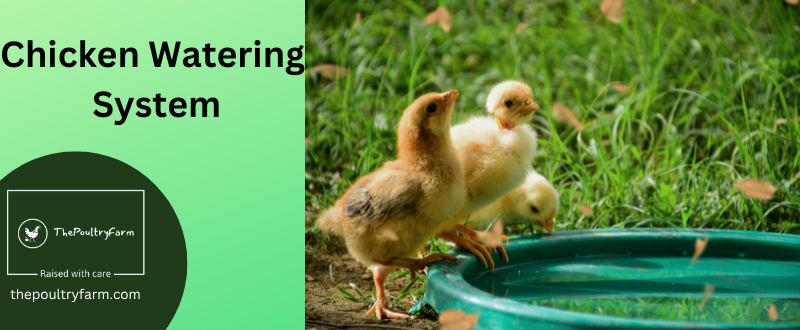
Introduction
Chickens are one of the most common backyard animals, but they can be a bit of a pain to take care of. One of the most tedious chicken chores is having to fill and refill their water dishes multiple times a day. Be that as it may, imagine a scenario in which there was a method for computerizing this cycle. Luckily, there is! This blog post will show you how to make an automatic chicken waterer that will save you time and effort. We’ll also provide some tips on how to keep you developing an automatic chicken watering system
What You’ll Need
To make an automatic chicken waterer, you will need the following tools and equipment:
- A five-gallon bucket
- An aquarium air pump
- An automatic float valves
- A lid for the bucket
- A water source (like a hose or spigot)
- An auto shut-off valve
- PVC piping
- PVC glue
- A drill
- 1/2-inch drill bit
- A saw (to cut the PVC piping)
- Scissors
- Sandpaper
Making the Waterer
Following is the procedure one should follow to perform the correct way of developing a waterer.
1. Drill a hole in the bottom of the bucket large enough to accommodate the PVC tubing.
2. Thread the PVC tubing through the hole and into the bucket. Tape the end of the tubing to the inside of the bucket so that it doesn’t come out.
3. Affix the aquarium air pump to the outside of the bucket with duct tape. Make sure that the airflow is directed into the bucket.
4. Attach one end of the automatically closing float valve to the PVC tubing inside the bucket and screw it on tight. The other end of this valve goes into a container of water that you will keep full. We suggest using a one-gallon jug or something similar in size.
Attaching the Waterer to the Faucet
A chicken waterer is a need for any chicken coop. It is vital to keep the chickens hydrated, particularly in a warm climate. There is a wide range of kinds of chicken waterers available. However, one of the most helpful is the spigot-mounted waterer.
To connect the chicken waterer to the fixture, just screw the given connector onto the fixture and afterward screw on the waterer. Ensure that the O-ring seal is set up and fix everything. When the waterer is gotten to the fixture, open the valve and let the water stream into the reservoir.
It is vital to mind the water level consistent and tops off depending on the situation. In blistering climate, it is particularly important to watch out for the water level and top off on a case-by-case basis. By utilizing a fixture-mounted chicken waterer, you can guarantee that your chickens generally have new, clean water.
To attach the chicken waterer to the faucet, first, make sure that the rubber washer is in place on the faucet adapter. Next, screw the adapter onto the faucet until it is tight. Finally, screw the waterline onto the adapter.
Maintaining the Waterer
One of the main concerns people have when getting chickens is making sure they have a good source of water. This is especially true in the winter when the cold can make the water turn to ice very quickly.
One of the biggest problems with keeping a waterer is that it can freeze and become unusable. It can happen at any time but usually happens in the winter when the temperature is below freezing, and the ground is frozen. Because of this, the waterer can become frozen, and the chickens cannot get water from it.
When this happens, the chickens will be out of the water, and you will have to run back out in the cold to get them more water. When the water is freezing, you can use a few different things to avoid the said phenomenon.
You can put the waterer in the sun, heat the waterer with a heat lamp, or use a hot water bottle. You can use all these methods to thaw the water in the tube. Once you have thawed the water, you can refill it and your chickens will be fine.
Apply these techniques to avoid water from freezing
- Line the waterer with aluminum foil.
- On a warm day, run the water under hot water.
- If the water is still frozen in the waterer, put the waterer in a spot where it will not freeze.
It is important to maintain your chicken waterer regularly to ensure that it continues to function properly. Here are some tips for maintaining your automatic chicken waterer:
- Clean the waterer regularly with soap and water.
- Check the float valve monthly to make sure it is working properly.
- Clean the basins and reservoirs weekly to prevent algae growth.
- Replace the water in the reservoir every few days to keep it fresh.
Benefits
These waterers save both your back and time, and that is the reason we love them. We have made them on a portable stand, so you can move them to a more helpful or focal area as needs are. Assuming you have an electric poultry netting run, these are great.
Additionally, they are self-filling, important because there’s less work for yourself and all the newer water preposterous. They have 24-hour admittance to new run water with no stand-by time, and you don’t need to convey weighty 5-gallon waterers this way and that.
To add to these advantages, these are a lot simpler to clean than a customary waterer. There is no unique water pressure decrease gear you want to purchase since this gadget connects to a customary nursery hose and uses no power.
I likewise like that there is a greater supply of water, in contrast to areola feeders. If there were ever an issue with the hose, you have additional time before the birds run out of water. Along these lines, you realize that your hens can constantly get how much water they need.
Conclusion
A chicken waterer is a must-have for any backyard chicken coop. Choosing the right chicken waterer is important to keep your chickens healthy and happy. In this article, we’ll discuss the different types of chicken waterers and help you choose the best one for your needs.
There are many different types of chicken waterers available on the market today. The most common type of chicken water is hanging water. This type of chicken waterer hangs from the side of the coop and is easy to fill and clean.
Another popular type of chicken waterer is the automatic chicken waterer. This type of chicken waterer automatically fills and refills the water bowl as needed. This is a great option for those who don’t have time to check on their chickens daily to refill their water bowl.
With this automatic chicken waterer, you’ll never have to worry about your chickens getting enough water. This simple DIY project is easy to build and only requires a few supplies that you likely already have around the house. Plus, it’s a great way to reuse an old plastic bottle. Your chickens will thank you for giving them this refreshing new way to stay hydrated!
I am passionate about chickens and how best to raise a healthy flock. I have been raising chickens for over 10 years now, and I am always looking for new and innovative ways to keep my chickens happy and healthy. In addition to keeping my own flock, I also putting reviews on the essential products that are required to keep Chicken happy. I hope to help as many people as possible learn how to properly care for their chickens!
Leave a Reply
